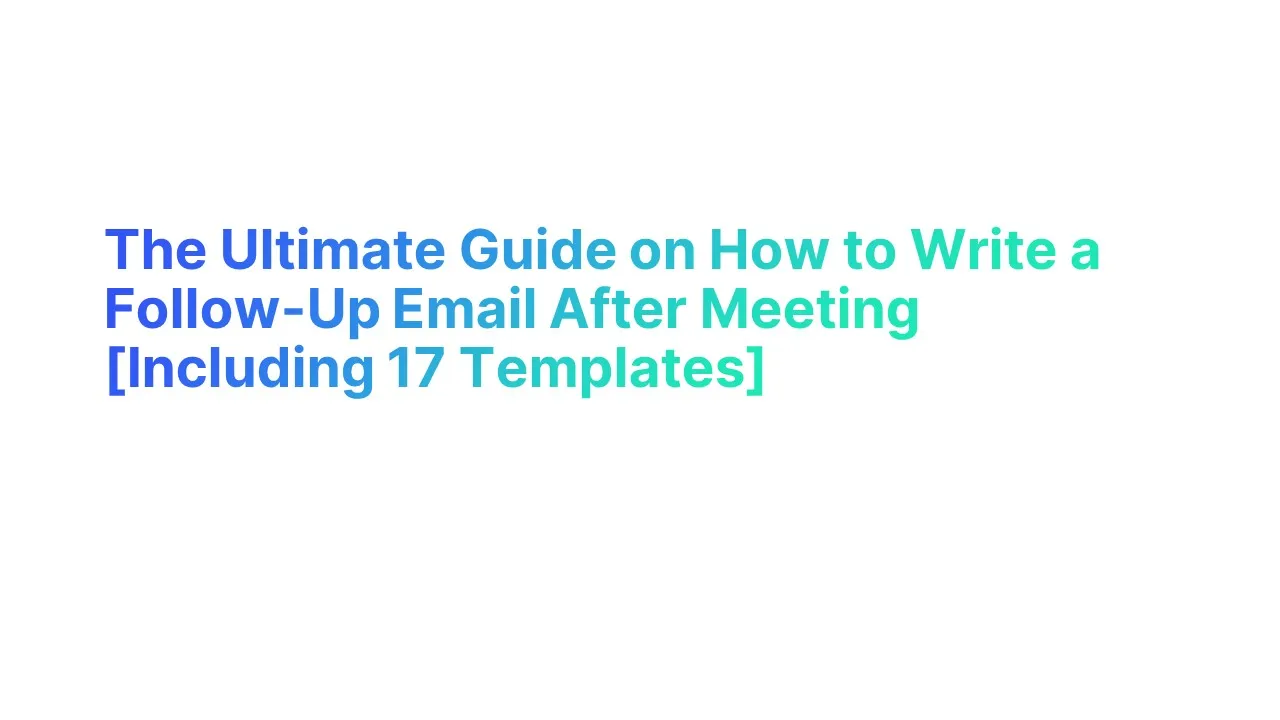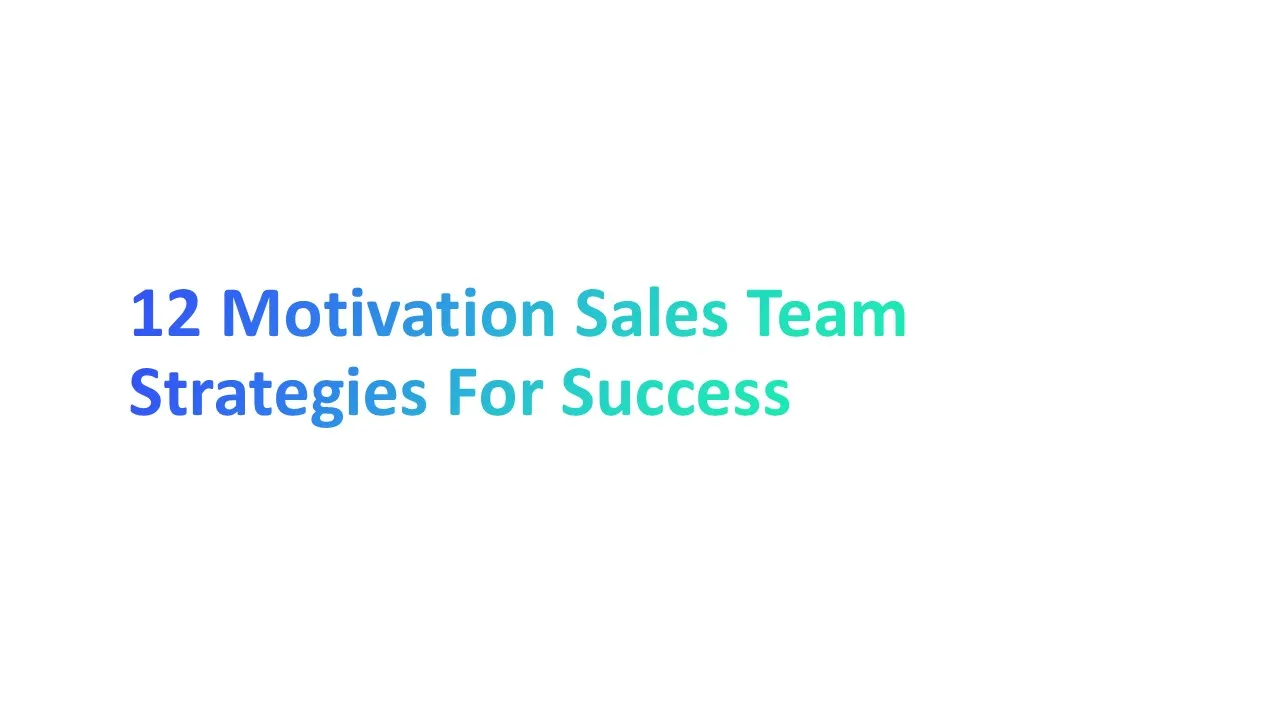Follow-up emails are your second shot at making a lasting impression. Whether you're aiming to seal a deal, forge a partnership, or open doors to future opportunities, the right follow-up can make all the difference.
Unfortunately, A lot of people have trouble getting replies from potential customers even after sending a few follow-up emails. But, if you use the right method, you can get answers and push your deal ahead.
A follow-up email can ensure both parties that they are on the same page regarding responsibilities and timelines, helping to prevent misunderstandings and maintain a clear path forward.
Why are Follow-Up Emails Important

Follow-up emails are a pivotal component in modern professional communication, serving multiple key functions that enhance relationships, drive engagement, and support business goals. Here’s why they are crucial:
Ensures Visibility in Busy Schedules
In the fast-paced world of business, follow-up emails ensure your message doesn’t get lost. They accommodate the recipient's schedule, allowing them to engage with your content at their convenience.
Facilitates Appreciation and Personalization
Saying "Thank you" personalizes the interaction. Using the recipient's name, acknowledging specific contributions or insights they shared, and referencing particular discussions from your meeting can increase the value of your communication. Personalization, beyond mere templates through mail merge techniques, shows genuine appreciation and attention to detail.
Maintains and Extends Conversations
Particularly for sales and networking, follow-up emails keep the dialogue flowing. They offer a touchpoint for re-engagement, reminding the recipient of your discussion and paving the way for further interactions. Whether it’s clarifying points from a previous meeting or discussing new opportunities, follow-up emails keep the connection alive and relevant.
Positions You as a Resource
Follow-up emails are an excellent opportunity to provide additional value. By sharing relevant articles, case studies, or other resources, you reinforce your role as a trusted advisor and source of useful information. This not only enriches the relationship but also supports the recipient's decision-making process with evidence and insights.
How to Write a Follow-Up Email After a Meeting
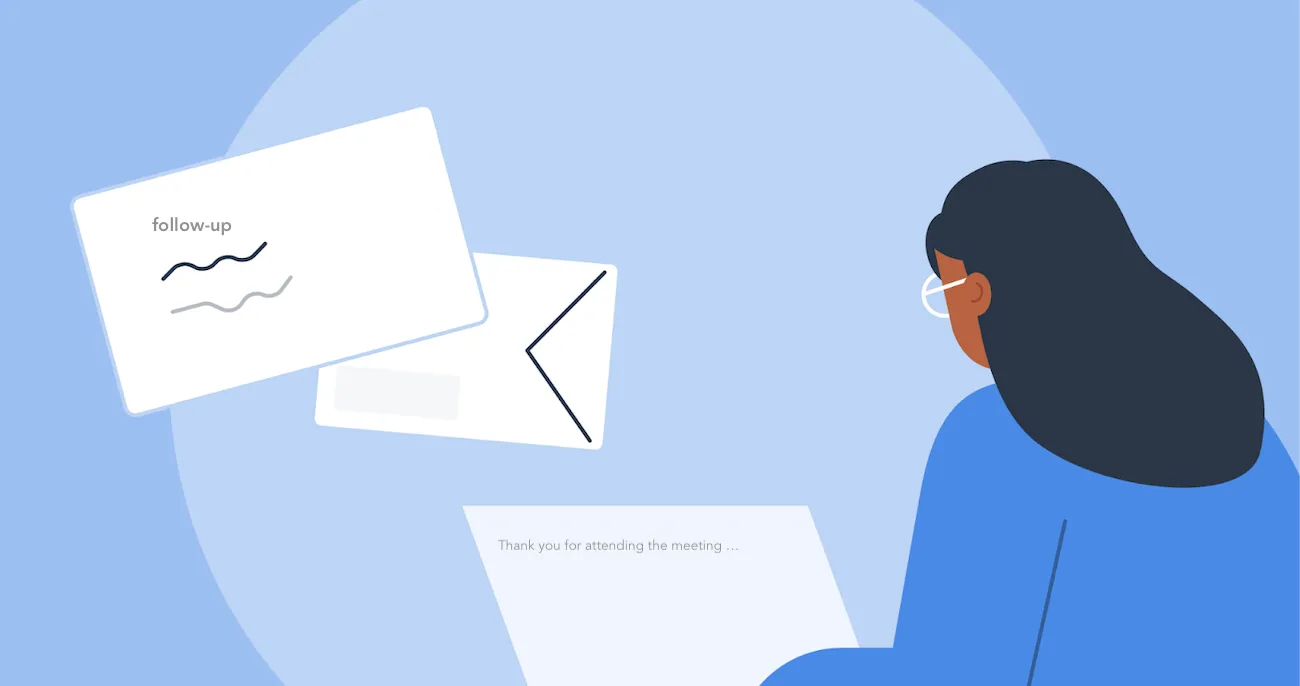
To craft an follow-up email after the meeting, Your email message should have these 5 key elements
5 Key Elements of a Follow-up Email Message after a Meeting
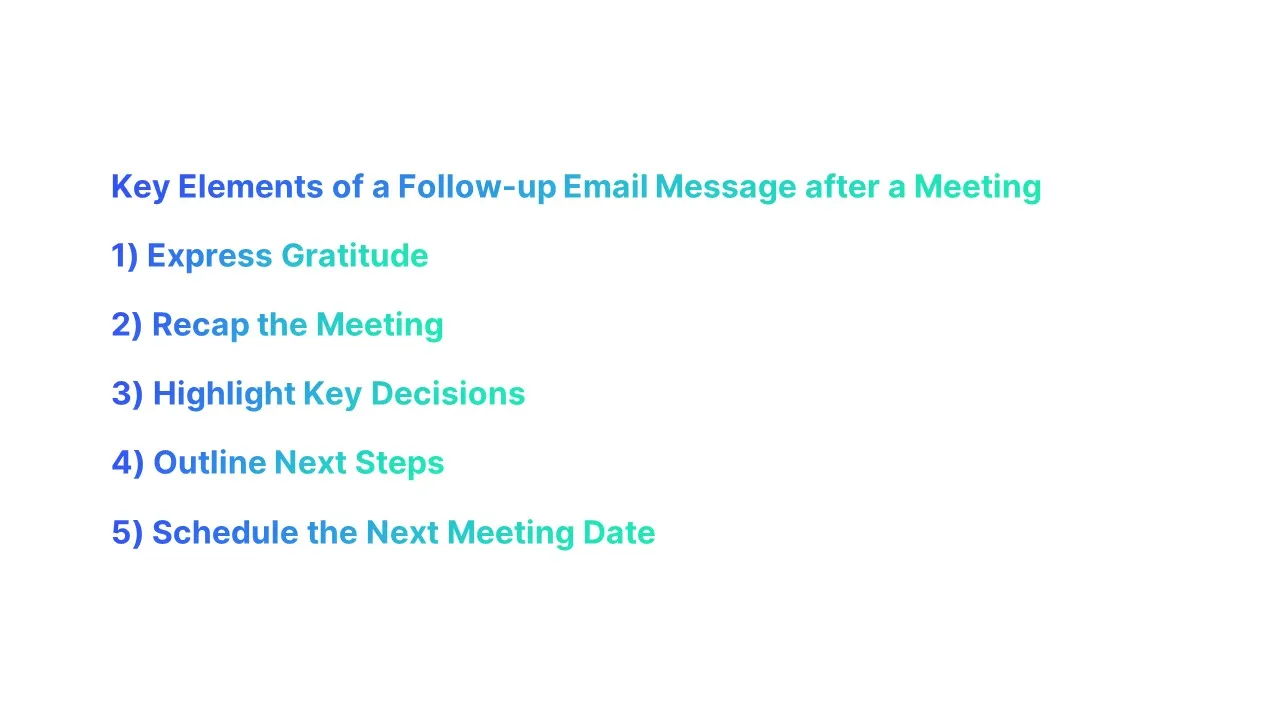
Express Gratitude
Start by thanking attendees for their time, acknowledging the value of their participation. This sets a positive tone and shows appreciation for their contribution.
Recap the Meeting
Provide a concise meeting recap, ensuring all attendees are on the same page. Include a bullet-point list of topics covered, action items assigned, meeting notes, and any reference documents shared during the meeting.
Highlight Key Decisions
Emphasize the main outcomes and decisions made to reinforce the meeting's purpose and ensure clarity on what was agreed upon.
Outline Next Steps
Clearly state the action items, who is responsible for each, and any deadlines. This accountability aids in tracking progress and ensures tasks are completed as planned.
Schedule the Next Meeting Date
Conclude by mentioning the date of the next meeting. If not already scheduled, suggest potential dates or include a call to action to finalize the scheduling. This keeps the momentum going and ensures continuous engagement.
Basic Elements of a Follow-Up Message
Creating a successful follow-up message involves attention to its structure, ensuring each part—from the subject line to the closing—engages the recipient and prompts action. Here’s how to optimize each element:
Subject Line: Crafting Captivating Subject Lines for Your Follow-Up Emails
- Be Specific and Relevant: Tailor the subject line to the meeting’s context or the email’s purpose. For instance, "Next Steps Following Our Marketing Strategy Session" immediately tells the recipient what to expect.
- Incorporate Personalization: Use the recipient's name or specific details from the meeting to grab attention. For example, "Alex, Your Insights on Project X – What’s Next?"
- Create Urgency or Curiosity: Encourage the recipient to open the email by hinting at valuable information or next steps. "Urgent: Your Feedback Required for Project Deadline" or "Discover What’s Next for Our Collaboration" can be effective.
Follow-up meeting email subject line example:
1. "Follow-Up: Action Items for Our Team After Yesterday’s Brainstorming Session"
- This subject line is specific and relevant, indicating the email will detail the next steps after a brainstorming session, making it clear what the email contains.
2. "Emma, Your Expertise Needed: Next Steps on the Product Launch Plan"
- Incorporates personalization by directly addressing the recipient and specifies the context, enhancing the importance of their contribution to the project.
3. "Urgent: Finalizing Our Q4 Targets – Your Input Needed by Friday"
- Creates a sense of urgency, prompting the recipient to prioritize reading and responding to the email, with a clear deadline for action.
4. "Thank You, Team! Celebrating Our Success and Planning Ahead"
- A positive and engaging subject line that acknowledges past achievements and hints at future planning, likely to encourage opening.
5. "Jake, Your Thoughts on Our Discussion Today?"
- Personalized and inviting feedback or further thoughts on a recent discussion, making it relevant and direct to the recipient.
6. "Discover the Future: Next Phase in Our Innovation Journey Together"
- Sparks curiosity about upcoming plans or projects, inviting the recipient to engage with the content to learn more about future collaborations.
Body Content: Structuring Your Email for Maximum Impact
- Opening with Appreciation: Always start by thanking the recipient for their time or contributions. This not only shows gratitude but also sets a positive tone for the message.
- Clear and Concise Recap: Briefly summarize the key points discussed, decisions made, and any consensus reached during the meeting. This serves as a reminder and helps keep everyone aligned.
- Action Items and Responsibilities: Clearly outline what needs to be done, by whom, and by when. This clarity helps prevent misunderstandings and ensures accountability.
- Use Bullet Points or Numbered Lists: For ease of reading and to make important information stand out, organize action items, key decisions, or next steps in a list format.
- Provide Value: Include any promised resources, links, or attachments discussed during the meeting. Offering additional insights or helpful materials can further engage the recipient.
Closing: Professional Sign-Offs and Call to Action
- Encourage Response or Further Action: End with a clear call to action, whether it’s scheduling another meeting, providing feedback, or completing a task. For example, "Please share your feedback by [date]" or "Let’s schedule a follow-up call to discuss further."
- Sign Off Professionally: Use a professional closing that matches the tone of your email, such as "Best regards," "Sincerely," or "Thank you again," followed by your name and contact information.
- Invite Further Communication: Make it clear that you are open to questions or further discussions. This can be as simple as saying, "Feel free to reach out if you have any questions or need clarification on the next steps."
Follow up meeting email closing examples
1. Best regards
- "I look forward to your insights on this matter. Please share your feedback by [date]. Should you have any questions, I’m just an email away."
Best regards,
[Your Name]
[Your Contact Information]
2. Sincerely
- "Let’s aim to finalize the details by our next meeting. Can we schedule a follow-up call early next week to discuss further? I’m available for any preliminary queries you might have."
Sincerely,
[Your Name]
[Your Contact Information]
3. Thank you
- "Your input is invaluable to us. Please let me know your thoughts on the proposal at your earliest convenience. I’m here for any clarifications you may need."
Thank you,
[Your Name]
[Your Contact Information]
4. Warm regards
- "To ensure we stay on track, kindly confirm the receipt of the attached documents by [date]. Feel free to reach out if you require any further information or assistance."
Warm regards,
[Your Name]
[Your Contact Information]
5. Kind regards
- "Your feedback is crucial for our next steps. Please review the attached overview and share your insights. I’m available for a call or meeting to delve deeper into any aspects you’re interested in."
Kind regards,
[Your Name]
[Your Contact Information]
6. Respectfully
- "I’m eager to hear your perspective on our discussion. Let’s schedule a time to reconvene and explore further avenues. Your questions and suggestions are always welcome."
Respectfully,
[Your Name]
[Your Contact Information]
Best Practices for When to Send Follow-Up Emails After a Meeting

Best practices for when to send follow-up emails after meetings are crucial for maintaining momentum and ensuring that the discussion translates into actionable outcomes. Here are the key guidelines:
1. Timing is Key
Within 24 Hours: Ideally, send your follow-up email within 24 hours of the meeting. This ensures the discussion is still fresh in everyone's mind and conveys your commitment to moving things forward.
2. Leverage the Context
After Morning Meetings: If your meeting is in the morning, sending a follow-up on the same day can be very effective.
After Afternoon Meetings: For meetings that occur later in the day, sending a follow-up the next morning works best, giving you time to organize your thoughts and the recipient time to settle back into their routine.
3. Adjust According to Urgency
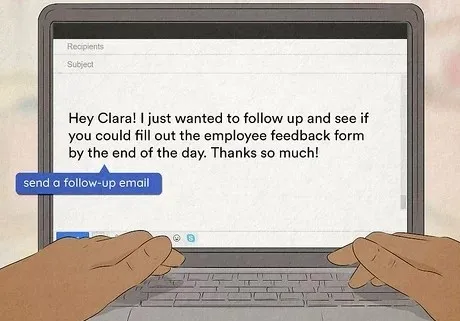
Immediate Next Steps: If there are urgent action items or decisions needed quickly, prioritize sending your email sooner rather than later to keep the momentum.
Longer-Term Projects: For meetings related to projects with longer timelines, ensure your follow-up includes a clear schedule for next steps, even if immediate action isn't required.
4. Consider the Recipient's Schedule

Avoid Weekends and Holidays: Be mindful of the recipient's work schedule, including weekends and holidays. Emails sent during these times may be overlooked.
Respect Time Zones: If working across time zones, consider the recipient's working hours to increase the likelihood your email is seen promptly.
5. Follow Up on Missed or Unresponsive Recipients
Second Follow-Up: If you haven't received a response to your initial follow-up within a week, it's appropriate to send a polite reminder, reiterating the importance of the discussed action items or decisions.
6. Utilize Tools and Technology
Scheduling Tools: Use email scheduling tools to send your follow-up at an optimal time if you're drafting it outside of normal business hours.
CRM Integration: For sales and business development professionals, integrating follow-up actions into your CRM can help track engagement and ensure timely follow-ups.
17 Templates for Effective Follow-Up Emails After a Meeting
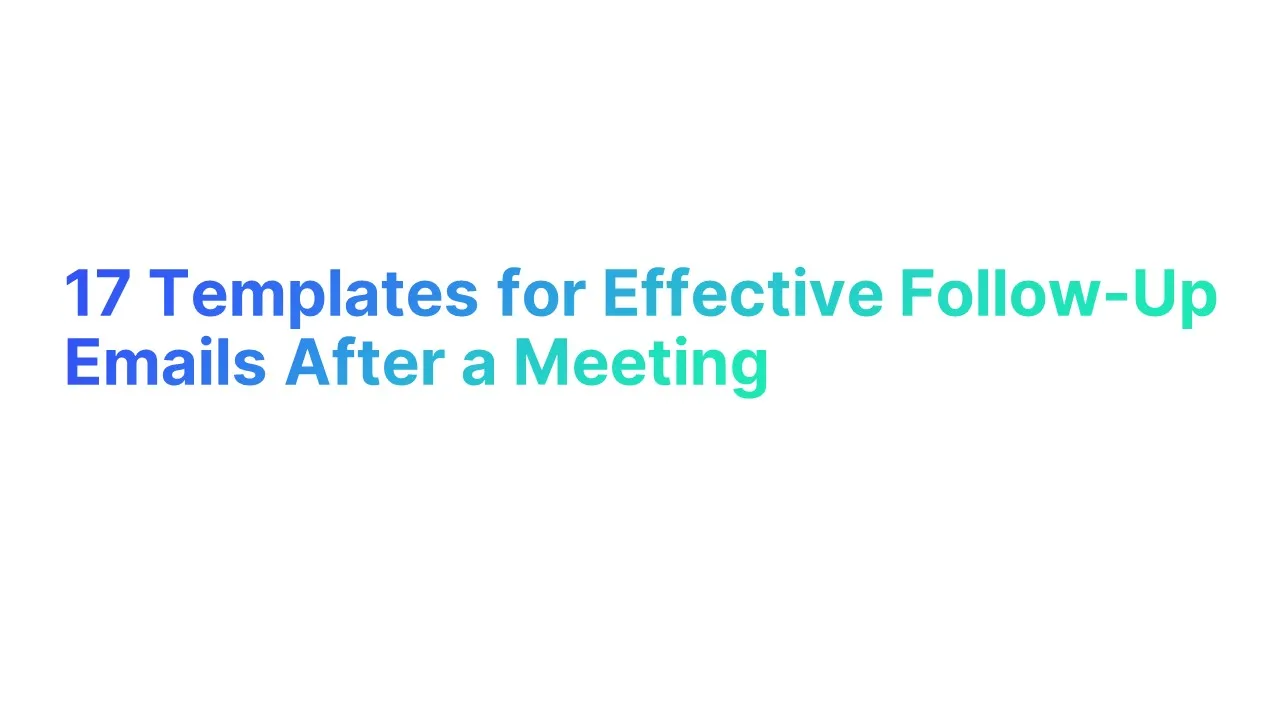
Follow-Up Email Templates for Every Business Meeting Scenario
Here are 17 templates for effective follow-up emails after a meeting, each designed to address different objectives and outcomes from your interactions. Customize your follow-Up email templates for different business meetings
Template 1: Thank You for the Insightful Meeting
Template 2: Recap and Next Steps After Our Discussion
Template 3: Following Up on Our Business Meeting
Template 4: Action Items Confirmation Post-Meeting
Template 5: Request for Further Information
Template 6: Scheduling a Follow-Up Meeting
Template 7: Feedback Request on the Recent Meeting
Template 8: Expressing Continued Interest
Template 9: Addressing Unresolved Questions
Template 10: Proposal Follow-Up After Initial Meeting
Template 11: Checking In Post-Networking Event
Template 12: Follow-Up for Additional Insights
Template 13: Collaboration Opportunity Follow-Up
Template 14: Follow-Up on Pending Decisions
Template 15: Reinforcing the Value Proposition
Template 16: Post-Sales Meeting Follow-Up
Template 17: Follow-Up After Sending Requested Documents
Analyzing Follow-Up Email Responses
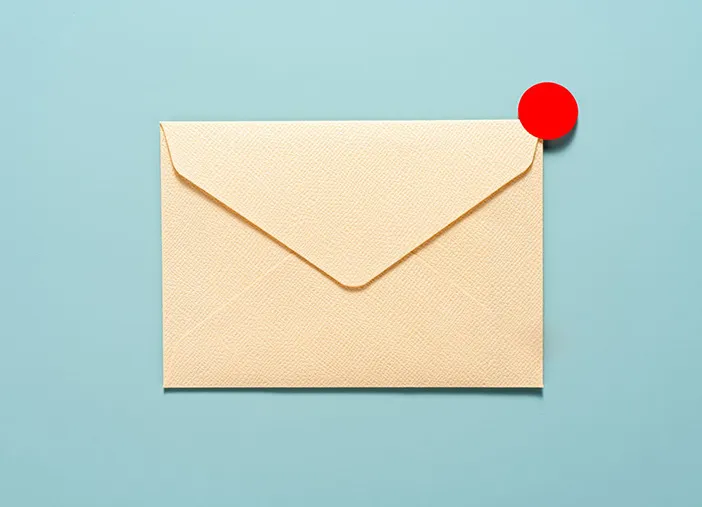
Analyzing and interpreting responses to your follow-up emails is crucial for effectively moving forward with your objectives.
The nature of the response can offer valuable insights into the recipient's level of interest, concerns, and readiness to proceed.
Here’s how to interpret various types of responses and suggested next steps:
1. Positive Response
- Characteristics: Expresses interest, agreement, or readiness to take the next steps. May include specific questions about the process or request more details.
- Example: "Thank you for the follow-up. We reviewed your proposal and are excited to discuss how we can implement this. Could we schedule a meeting next week to finalize details?"
- Next Steps: Quickly address any questions or provide requested information. Solidify commitment by proposing dates for the next meeting or deadlines for action items. Maintain momentum by being responsive and clear on what is needed next.
2. Neutral Response
- Characteristics: Acknowledges receipt of the email without expressing clear interest or disinterest. The response may be vague or non-committal.
- Example: "Thanks for your email. I'll need some time to think about this and discuss it with my team."
- Next Steps: Engage the recipient by asking open-ended questions to gauge their interest or concerns. Offer additional information or clarification that could persuade them towards a positive stance. Propose a call or meeting to discuss further.
3. Request for More Information
- Characteristics: Indicates interest but signifies the need for additional details before making a decision. This can be about pricing, technical specifications, or implementation processes.
- Example: "Can you provide more details on how your solution integrates with our current systems? Specifically, we are interested in security features."
- Next Steps: Provide the requested information in a clear and organized manner. Highlight key benefits or features relevant to the recipient's needs. Follow up to confirm receipt of the information and offer to answer any further questions.
4. Delayed Response
- Characteristics: A reply that comes significantly after your follow-up email, possibly indicating busyness, indecision, or lower priority.
- Example: "Apologies for the delayed reply. We've been swamped. Your proposal is still under consideration, and we'll get back to you in a couple of weeks."
- Next Steps: Acknowledge the response graciously, reiterate key points briefly, and suggest concrete next steps. Be flexible but try to secure a commitment for a follow-up action or meeting.
5. Negative or Declining Response
- Characteristics: Clearly states a lack of interest or inability to proceed with the proposal or project. May or may not provide reasons.
- Example: "After careful consideration, we've decided not to proceed with the proposal at this time due to budget constraints."
- Next Steps: Respond professionally, thanking them for their consideration. If appropriate, ask for feedback on the decision. Keep the door open for future opportunities by expressing your willingness to reconnect at a later time.
6. No Response
- Characteristics: No reply after a reasonable amount of time, leaving the status of your follow-up uncertain.
- Next Steps: Consider sending a polite reminder email, reiterating the value or proposition discussed and expressing your eagerness to hear back. If there’s still no response, evaluate the timing for another follow-up or decide to move on, depending on the context.
Interpreting Silence or Ambiguous Replies
- Silence or non-specific replies can be challenging to interpret. It’s important not to jump to conclusions but instead consider factors like timing, the recipient's typical communication patterns, and current priorities. A follow-up call or a more personalized email may help clarify their position.
Common Mistakes in Follow-Up Emails and How to Avoid Them
Follow-up emails are a critical component of professional communication, but common mistakes can undermine their effectiveness. Recognizing and avoiding these pitfalls can greatly enhance the impact of your follow-up efforts. Here’s a rundown of common mistakes and strategies to avoid them:
1. Lack of Personalization
- Mistake: Sending generic emails that don’t acknowledge the recipient's contributions or the specifics of the meeting.
- How to Avoid: Always tailor your follow-up emails. Use the recipient’s name, reference specific discussion points, and personalize the message to reflect the conversation and relationship.
2. Sending Too Late
- Mistake: Waiting too long after the meeting to send the follow-up, causing the discussion to no longer be top of mind.
- How to Avoid: Aim to send your follow-up email within 24 hours of the meeting. This ensures the conversation is still fresh and demonstrates promptness and professionalism.
3. Overwhelming Recipients with Information
- Mistake: Including too much information or too many requests in one email, making it difficult for the recipient to identify the key points or next steps.
- How to Avoid: Be concise and clear. Summarize the key points, outline specific next steps, and prioritize clarity. If necessary, attach documents for detailed information but summarize their content in the email.
4. Forgetting to Include a Call to Action
- Mistake: Ending the email without a clear call to action, leaving recipients unsure of the expected next steps.
- How to Avoid: Conclude your email with a specific call to action. Whether it’s scheduling another meeting, providing feedback, or completing an action item, make it clear what you are asking of the recipient.
5. Omitting a Subject Line or Writing a Vague One
- Mistake: Using a subject line that is unclear or irrelevant, reducing the likelihood that the recipient will open the email promptly.
- How to Avoid: Craft a subject line that is specific and reflective of the email’s content. For instance, "Next Steps from Our Meeting on [Date]" clearly indicates the email's purpose.
6. Ignoring the Follow-Up
- Mistake: Not sending a follow-up at all, missing the opportunity to reinforce the conversation, clarify next steps, or maintain the relationship.
- How to Avoid: Make it a standard practice to send a follow-up email after every meeting. Even a brief message can be effective in keeping the dialogue open and moving forward.

